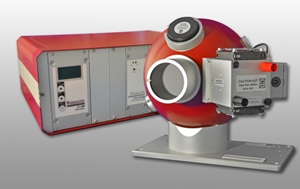Gigahertz-Optik introduces the ISS-17-VA Integrating Sphere Source calibration standard for spectral radiance and luminance. A unique and key feature of Gigahertz-Optik ISS series is a variable light intensity output while maintaining a constant color temperature.
 ISS-17-VA Integrating Sphere Source
ISS-17-VA Integrating Sphere Source
The term “Uniform Light Source” best describes the distinguishing property of an “integrating sphere light source” as it produces an illuminance field with excellent luminance homogeneity. Through spectral radiance calibration of the illumination field the integrating sphere light source can be used as a calibration standard for comparison of imaging spectrometers as well as for spectral radiance calibration of spectral meters. In these applications halogen lamps at 3100K color temperature are used to ensure optimum intensity in the blue spectral range. Another desirable feature of halogen lamps as spectral radiance and luminance calibration standards is a continuous and stable luminous spectrum. According to many published standards this type of lamp (CIE Standard Illuminant A) is specified for luminance responsivity calibrations at 2856K color temperature.
The ISS-17-VA Integrating Sphere Light source is 170 mm in diameter with a 50 mm diameter illumination field. The sphere is coated with Gigahertz-Optik GmbH’s own highly diffuse and reflective Barium Sulfate. The coating provides a hemispherical scattered reflection over its entire usable spectral range. The light source is designed in the form of a simplified satellite sphere thereby guaranteeing homogenous light distribution within the sphere. Thanks to an adjustable aperture between the light source and the integrating sphere the intensity of the spectral radiance and luminance can be varied while maintaining a constant color temperature. A reference detector on the integrating sphere monitors the luminance level and color temperature. This enables the ISS to be operated at 2856K and 3100K color temperatures.
Internationally traceable luminance, spectral radiance and color temperature calibration is performed and certified by Gigahertz-Optik’s optical radiation calibration laboratory following ISO 17025 guidelines.
For more information please visit: http://www.gigahertz-optik.de/147-1-ISS-17.html